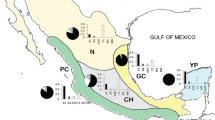Abstract
The Africanization process of the honeybee Apis mellifera in America is considered one of the most spectacular biological invasions documented so far. It started in São Paulo (Brazil) in 1956 and the process has extended to almost all the continent (from the United States, to Argentina and Uruguay). The aim of this study was to evaluate the present status of Africanization in Uruguay after 40 years of its entrance, as well as to determine the circulating honeybee haplotypes through genetic (mitochondrial DNA) and morphometric approaches. Results showed that Africanized bees are completely established in Uruguay, representing 80 % of the analyzed colonies, distributed throughout the whole country. A great genetic diversity was found, detecting eight different haplotypes. Some of them have been previously reported in the country, while others are new. The persistence of the non-African haplotypes in western provinces (Paysandú, Río Negro, Soriano and Colonia) may be due to a strong importation of European queens. This fact is probably avoiding the complete Africanization of the Uruguayan colonies.

Similar content being viewed by others
References
Abrahamovich, A.H., Atela, O., De la Rúa, P., Galián, J. (2007) Assesment of the mitocondrial origin of honey bees from Argentina. J. Apic. Res. and Bee World. 46, 191–194
Burgett, M., Shorney, S., Cordara, J., Gardiol, G., Sheppard, W.S. (1995) The present status of Africanized honey bees in Uruguay. Am. Bee J. 135, 328–330
Clarke, K.E., Oldroyd, B.P., Javier, J., Quezada-Euan, G., Rinderer, T.E. (2001) Origin of honeybees (Apis mellifera L.) from the Yucatan peninsula inferred from mitochondrial DNA analysis. Mol. Ecol. 10, 1347–1355
Collet, T., Ferreira, K.M., Arias, M.C., Soares, A.E.E., Del Lama, M.A. (2006) Genetic structure of Africanized honeybee populations (Apis mellifera L.) from Brazil and Uruguay viewed from mitochondrial DNA COI-COII patterns. Heredity. 97, 329–335
Cordara, J.J. (2005) La Historia de la Apicultura en Uruguay. Facultad de Ciencias Agrarias. Universidad de la empresa, Montevideo, Uruguay
Diniz, N.M., Soares, A.E.E., Sheppard, W.S., Del Lama, M.A. (2003) Genetic structure of honeybee populations from southern Brazil and Uruguay. Genet. Mol. Biol. 26, 47–52
Franck, P., Garnery, L., Loiseau, A., Oldroyd, B.P., Hepburn, H.R., Solignac, M., Cornuet, J.-M. (1998) Genetic diversity of the honeybee in Africa: microsatellite and mitochondrial data. Heredity. 86, 420–460
Garnery, L., Cornuet, J.M., Solignac, M. (1992) Evolutionary history of the honeybee Apis mellifera inferred from mitochondrial DNA analysis. Mol. Ecology. 1, 145–154
Garnery, L., Solignac, M., Celebrano, G., Cornuet, J.M. (1993) A simple test using restricted PCR-amplified mitochondrial DNA to study the genetic structure of Apis mellifera L. Experientia. 40, 1016–1021
Kerr, W.E. (1957) Introduction of african honey bees in Brazil. Brasil Apicola. 3, 211–213
Kim, K.T., Oguro, J. (1999) Update of the Status of the Africanized Honey Bees of the Western States. West. J. Med. 170, 220–222
MGAP. (2012). Anuario 2012. www.mgap.gub.uy/
Rinderer, T.E., Sylvester, A., Buco, S.M., Lancaster, V.A., Herbert, E.W., Collins, A.M., Hellmich, R.L. (1987) Improved simple techniques for identifying Africanized and European honey bees. Apidologie. 18, 179–196
Sheppard, W.S., Rinderer, T.E., Garnery, L., Shimanuki, H. (1999) Analysis of the Africanized honey bee mitochondrial DNA reveals further diversity origin. Genet. Mol. Biol. 22, 73–75
Smith, D.R. (1991) African bees in the Americas: Insights from Biogeography and Genetics. Tree. 6, 17–21
Walsh, P.S., Metzger, D.A., Higuchi, R. (1991) Chelex 100 as a medium for simple extraction of DNA for PCR-based typing from forensic material. Biotechniques. 10, 506–513
Whitfield, C.W., Behura, S.K., Berlocher, S.H., Clark, A.G., Johnston, J.S., Sheppard, W.S., Smith, D.R., Suarez, A.V., Weaver, D., Tsutsui, N.D. (2006) Thrice out of Africa: ancient and recent expansions of the honey bee, Apis mellifera. Science. 314, 642–645
Acknowledgements
The authors thank Ciro Invernizzi, Gustavo Ramallo, the Apiculure section of INIA La Estanzuela (Colonia, Uruguay) and the AMSUD Pasteur Foundation.
Author information
Authors and Affiliations
Corresponding author
Additional information
Manuscript editor: Marina Meixner
Modifications génétiques chez Apis mellifera après 40 ans d’africanisation
Abeille africaine / haplotype / ADN mitochondrial / Amérique du Sud / Uruguay
Genetische Veränderungen in Apis mellifera nach vierzig Jahren Afrikanisierung
Afrikanisierung / afrikaniserte Honigbiene / mitochondriale DNA / Haplotyp
Rights and permissions
About this article
Cite this article
Branchiccela, B., Aguirre, C., Parra, G. et al. Genetic changes in Apis mellifera after 40 years of Africanization. Apidologie 45, 752–756 (2014). https://doi.org/10.1007/s13592-014-0293-2
Received:
Revised:
Accepted:
Published:
Issue Date:
DOI: https://doi.org/10.1007/s13592-014-0293-2




